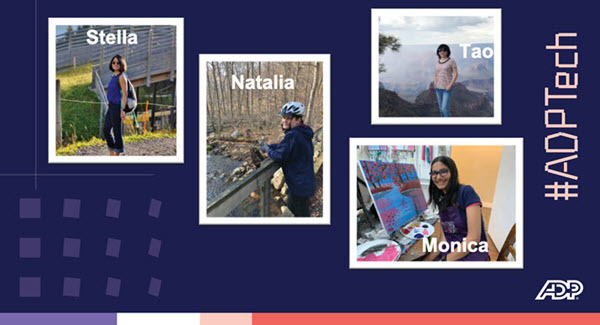Meet (some of) the Women of ADP DevOps

ADP is a 2020 Grace Hopper Award recipient for our commitment to diverse teams and the overall development of women, no matter where they are in their careers. One group of women within our DevOps team share their story of camaraderie and making a difference at ADP. Every day, they work in close support of one another to tackle exciting technical challenges and to drive data-centric development across the company.
We recently caught up with Monica Bansal (Application Developer), Natalia Ermolayeva (Senior Application Developer), Tao Hu (Principal Application Developer), and Stella Jia (Senior Director, Application Development). It was clear from our chat and how they complement each other's work why they've become such a tight-knit group. Below, they share what makes their collaboration work so well, their recent wins, and what they're excited to learn—and build—in the months and years to come.
What do each of you do at ADP, and why did you join the team?
Monica: My job is a blend of application development and data analytics—I assist ADP's data scientists with experiments and then build out the APIs. I've been with the company full-time for about a year now; I started as a summer intern while getting my master's in data science and computer science. I knew I wanted to continue my career in this field, and I liked getting to work with real data and implement it in the real world. I did another part-time internship last spring while finishing my degree, and then I joined Stella's team.
Tao: I'm a principal application developer, which means I build many of the libraries and components that allow our work to scale—they become the blueprint other teams implemented. I've been with ADP since 2013. Before that, I worked in finance as a Java developer. A friend of mine recommended ADP after my company moved farther from my home. I have two young boys, and I wanted to make sure I had time to take care of them. I knew ADP had a reputation for being a family-friendly employer.
When I started at ADP, my work focused on producing reports. But once Stella joined, our team shifted to more machine learning. I love problem-solving and simplifying processes, so it's been really fun for me.
Natalia: I'm a senior application developer, and I see my role as keeping data safe and available—I handle testing and operations. I'm very new to ADP; I joined about four months ago. One big attraction was the level of collaboration between departments. I was very impressed with the people who interviewed me. Everyone was very professional, and they mentioned many modern tools that I was excited to use. I knew ADP would be a good place to broaden my skills across a lot of different areas.
Stella: I'm a senior director for application development. My job is to lead the Application Development team and make sure we're delivering insights that will help ADP build better products. As Tao mentioned, that involves a lot of machine learning work and other statistical analysis, as well as data mining and visualization techniques. An intrinsic strength of this team is connecting the data to the real people we serve. When we look for patterns and anomalies, we're trying to figure out how we can make people's jobs easier as we ADP innovate and grow.
I joined ADP about four years ago; a mentor and friend I'd previously worked for recommended I apply. He had great things to say about the leadership and the vision for transformation from a service company to a technology company. The people were great, too, and I liked that I'd get to learn about a lot of domains I hadn't worked in before. I think it's an excellent environment for anyone who wants to grow by adding value and helping others.
How do you support each other's work?
Tao: We're helping each other every day, sharing results and ideas for new approaches. For example, we've been using a new data analysis tool to build some reports, and now we're looking at other projects that might benefit from those same functionalities. Because of our roles, Monica and I work especially closely, but I feel like I can pick up the phone or message anyone on the team when I have something to figure out, and I'll get help right away.
Natalia: Yes—I like that my teammates are always just a call or text away. Knowing each other as people, chatting and joking around makes it so much easier to communicate and work together. We're comfortable sharing ideas freely and collaborating, even when we're not in the same room.
Stella: Definitely. We'd love to hang out in person more, but even with everyone virtual, it's turned out really well. And that collaboration is so important. I think of the team as a set of pillars—if any of them aren't there, none of it works. Monica is doing the analytics and research, slicing and dicing the data. Once we've found something we want to build upon, Tao steps in to create that foundation. And then Natalia is there to make sure we're not only maintaining privacy but keeping things sustainable from an operations perspective. We all need each other, and we're all working toward the same goal and figuring out how to measure success, which could be a product's stickiness, preventing errors, or saving people time.
Monica: I think everyone on the team is naturally very passionate about working toward what we all want to achieve. You can always go to someone with a question, and everyone pitches in when someone needs help to make sure we're hitting our targets. Stella is great about making sure we're all happy and doing the kind of work we want to be doing.
Tell us about some of the ways you've made an impact at ADP.
Tao: We recently started using a new workflow manager tool, which has been a big win. Before, if we had a lot of ETL (extract, transform, load) jobs, we'd get files from other teams and load them into the database. With all the pieces and feeds, it wasn't easy to see the status of any particular piece. That was frustrating. Stella recommended a workflow tool, which I hadn't heard of at the time. After I got up to speed, we started building things out, adapting the data monitor and using the workflow manager to grab all the outputs, sending them to the monitor, and building the dashboards there. Now we have an accessible overview to see what's working and what isn't. It's been so helpful.
Natalia: Due to the nature of my work, success isn't always obvious. If things run smoothly, no one notices what happens in the background, which means I've done my job. As I get more familiar with how things work at ADP, I'll have some opportunities to automate more daily, repetitive tasks. That's a big priority.
Monica: We did an error-detection project recently where we built a model to help us flag problems on the back-end when a client runs their payroll and how users respond when they get those warnings. If we have a proper pipeline of data to run the model regularly, clients can see predictions for the entire week, and we can see whether they're using or ignoring the information, which tells us whether we need to make some corrections.
More broadly, our team helps others understand the importance and potential of data, especially here at ADP, where we have such rich data. We want to drive data-centric development, which starts with data collection. Before we can do the analytics, our data needs to be clean. So we work with a lot of other teams, helping them understand how to use the tools and making sure they're comfortable and up-to-date on everything they need.
Stella: We are part of a data-informed culture. Technology evolves quickly. At ADP, we want to stay ahead and be proactive rather than reactive. Data is a huge asset in that effort. It gives us much faster feedback loops and insights into our clients. We can quickly see when and whether a client's hitting a milestone.
But to leverage that asset, as Monica mentioned, we need a certain level of data literacy throughout the business. If developers understand how data can help them build a better product, it will be much easier to scale. Part of our team's job is to encourage data literacy. We also help establish standards, offer training, and get development teams running on an autonomous path to adopt a canonical format every team can follow. We find that it is contagious. Once a few teams embrace the data, other teams understand the benefits more quickly and have more colleagues to help them learn.
What are you excited to learn next?
Natalia: There are a lot of tools I'm excited to learn more about, including the ones my colleagues have mentioned. I'm looking forward to using new technologies in general, particularly machine learning tools. I think I'll have many opportunities to code for our team's internal purposes, for affirmation and monitoring, too. Because I'm new to the team, I'm also learning the big picture and how everything's connected. ADP is great with documentation, so I can find almost everything I need on my own. But I can always ask my colleagues or get up to speed through a learning session with one of our senior team members.
Tao: I'm excited to keep learning new technologies, too. I'll often jump over to educational resources to get a quick sense of something, then I come back and try to use it. The machine learning side of things is especially exciting. Besides learning new languages, I love new concepts for how to approach our work.
Monica: I feel like I've grown so much already! From the start of my first internship to now, I've been able to work on many different services and projects, from machine learning models to APIs to analytics. Whenever Stella says, "I have an idea," we get excited. The technologies are always changing, and that helps us grow.
Stella: One thing I'm thinking about is how to give developers more visibility into what we do. As Natalia mentioned, most of our foundational work tends to happen behind the scenes. We look forward to building stronger connections with our frontend partners, which will provide even more opportunities to enjoy the results and get recognition for our work.
At ADP, our talent pipeline is so important. It's about getting the right people and building a strong culture. We want the goal, in everything my team does, to be a better developer experience. We strive to make people happy, make their jobs easier, make their days more efficient. If we provide them with a platform that allows them to test and measure their ideas more quickly, they'll have more time to explore new ideas and innovate.
Learn more
Interested in a tech career at ADP? Check out open roles on tech.adp.com.
Read more stories like this on our ADP Tech blog.




